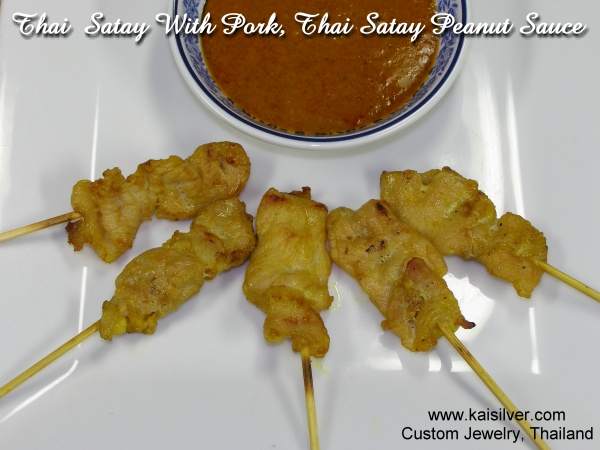Thai Satay, Meat On Sticks. Popular Thai Food.
 If you have ever travelled to Thailand on a vacation or are a lover of Thai food, the popular Thai food dish shown in this image is something that you would have never missed. Known by a few names, satay or Thai satay is sometimes called meat roasted on sticks, satay skewers, or even satay sticks. This dish has become so very popular in Thailand and infact across the globe that, few people are aware that the name 'satay' originated in Indonesia and not in Thailand. The Indonesians meant to give the name satay to a specific way of cooking meat. Thai satay or simply satay, uses the grilling or barbecueing form to cook the meat strips. This method of cooking is called satay in Indonesia. This is of academic interest today and for all of us, Thai satay is a popular Thai food dish that is available and relished in every street, home and province of Thailand. In general, you could refer to satay as meat satay but, the fact is that you have a few meat options when choosing satay sticks. The image shows satay make with pork meat, whereas beef and chicken could also be used to make satay skewers. The Kaisilver satay recipe is respected as the most comprehensive, clear and authentic recipe to make Thai satay. At first sight, the recipe looks quite complicated, the list of ingredients required to make the Thai satay seem to overwhelm the reader. However all you need to do is to stay calm and follow the step by step instructions. The excitement and adventure of making, eating and sharing your very own satay with satay peanut sauce is worth the effort.
If you have ever travelled to Thailand on a vacation or are a lover of Thai food, the popular Thai food dish shown in this image is something that you would have never missed. Known by a few names, satay or Thai satay is sometimes called meat roasted on sticks, satay skewers, or even satay sticks. This dish has become so very popular in Thailand and infact across the globe that, few people are aware that the name 'satay' originated in Indonesia and not in Thailand. The Indonesians meant to give the name satay to a specific way of cooking meat. Thai satay or simply satay, uses the grilling or barbecueing form to cook the meat strips. This method of cooking is called satay in Indonesia. This is of academic interest today and for all of us, Thai satay is a popular Thai food dish that is available and relished in every street, home and province of Thailand. In general, you could refer to satay as meat satay but, the fact is that you have a few meat options when choosing satay sticks. The image shows satay make with pork meat, whereas beef and chicken could also be used to make satay skewers. The Kaisilver satay recipe is respected as the most comprehensive, clear and authentic recipe to make Thai satay. At first sight, the recipe looks quite complicated, the list of ingredients required to make the Thai satay seem to overwhelm the reader. However all you need to do is to stay calm and follow the step by step instructions. The excitement and adventure of making, eating and sharing your very own satay with satay peanut sauce is worth the effort.
While we have provided you the link to the Thai satay recipe below, here are some very useful suggestions that you should keep in mind. Few Thai food recipe books provide such detailed information, so it is worth making a note of this web page, you will be rewarded with excellent results when cooking Thai food at home. Your friends, family and collegues who have been lucky enough to taste the Thai food dishes cooked by you will fill you with praise and thanks.
- Meat options: As mentioned above Thai satay can be made with pork, beef or even with chicken meat. Our satay recipe is very useful irrespective of what meat you choose to cook your satay with. Some foreign authors recommend the meat strips to be quite to a fairly long length, the satay recipe we provide suggests more modest dimensions. This makes it easier to cook and eat the meat satay.
- Marinade and Sauce: Many first time Thai food cooks, are confused with the two liquids related to Thai satay. The marinade, also called marinate is a solution used to soak the meat strips before your satay is put to on the grill to cook. On the other hand satay sauce or satay peanut sauce is a side dish with wish the cooked satay sticks are eaten with.
- Cooking Time: So when should you start making the satay. Two things need to be kept in mind, the first is that the satay sticks are best eaten as soon as they are cooked and taken off the grill. The other important thing is that there is a 30 to 40 minute soaking time required to soak (marinate) the meat strips in the marinade. So the starting time should be decided based on these two pieces of information. Also remember that you would be serving the Thai meat satay with satay sauce and also most probably include the cucumber relish side dish. Work that into the time required for your satay to ready to serve too.
- Threading the Meat: If you see the above image you will notice that the meat strips have a stick through them. This process of putting the stick or skewer through the meat strip is referred to as threading the meat. Professional Thai food cooks will not allow the top part of the stick to protrude from the top of the meat strips. This is because a stick that protrudes could burn and change the flavor of the satay meat.
- Meat Thickness: We would recommend that the meat strips, be about 2 inches long and 1 inch wide. For the thickness, keep it at around 0.5cm to 0.6cm. The thickness is an important feature that need to be given attention. If you make the meat strips too thick, you will end up taking a lot of time to cook the meat. It is also likely that the outside of the meat gets burnt by the time that the inside gets cooked. At the same time, cutting the meat strips too thin will make it difficult for you to thread the meat on the sticks or skewers.
- Aluminium Foil: This is really optional and many satay recipes don't even care to mention anything about the foil. Take another look at the Thai satay shown in the image, notice the bottom of the sticks. You will see that the sticks are not very burnt despite the fact that the satay is cooked on the grill. Professional cooks, wrap the bottom portion of the stick in aluminium foil - this prevents the sticks from burning.
- Pointed Sticks: For us this is more important than the taste of the satay as it concerns your safety. The sticks used to thread the meat are almost always pointed at the top. This will not be clearly visible as the stick would not protrude from the top of the meat. Make sure that children or adults are not hurt in any way with these sharp sticks. If you are blessed with over active kids, a good idea would be to slide the meat out of the stick after it is cooked. Place the cooked satay in a plate and pick with a fork.
Now that we have covered most of the important issues related to Thai satay and cooking Thai satay, you are ready to try your hand at making this very popular Thai food dish. Remember to share the satay or at least share this recipe with your friends, family and collegues. The satay recipe can be accessed here http://www.thaifood.food-recipe-cooking.com/thai-satay-recipe-frc-nv-01.htm
